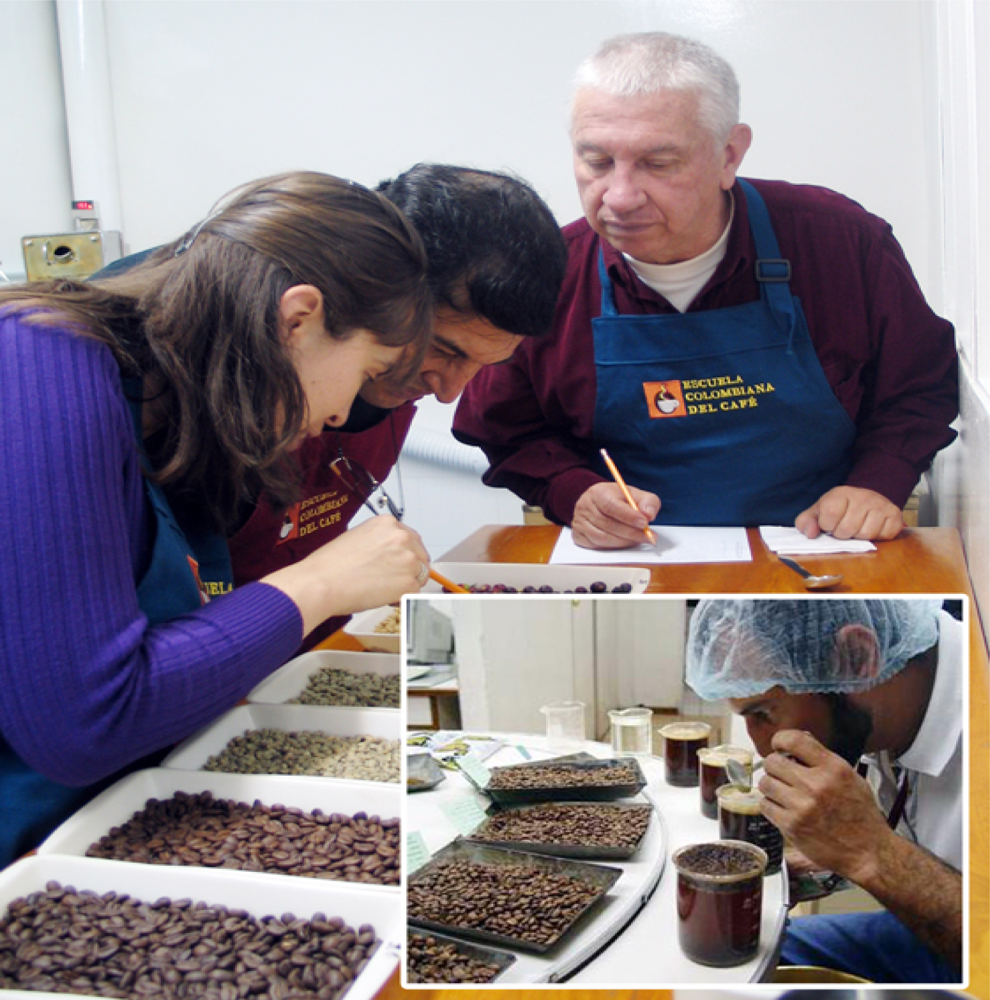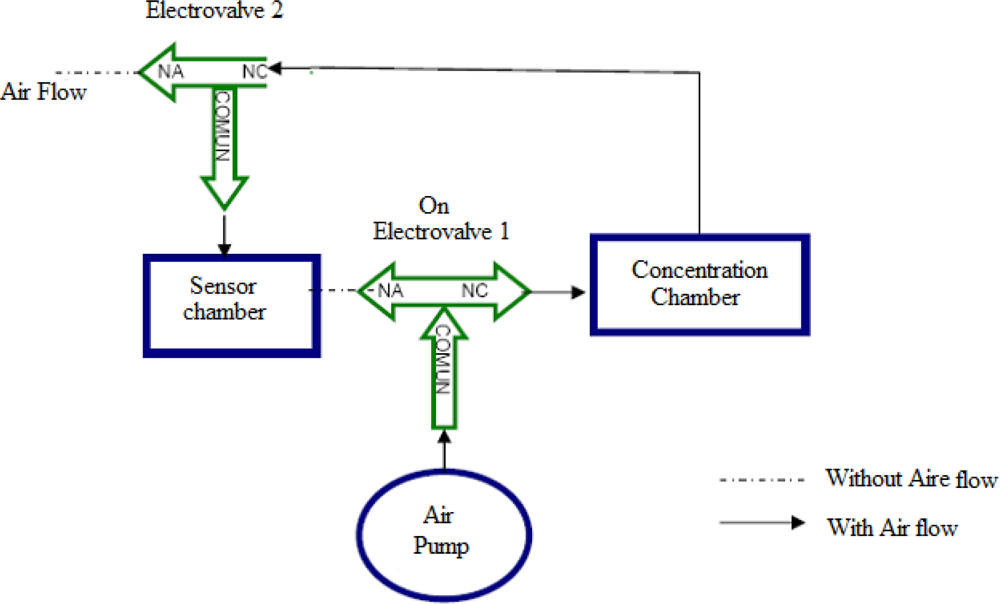Electronic Nose for Quality Control of Colombian Coffee through the Detection of Defects in “Cup Tests”
Abstract
:1. Introduction
2. Experimental
2.1. General Configuration
2.2. Parameters Used in the Measurement Processes
Measurement Times:
2.3. Equipment Configuration
3. Results and Discussion
3.1. First Analysis
3.2. Second Analysis
4. Conclusions
Acknowledgments
References
- Gardner, W.J.; Shurmer, H.V.; Tan, T.T. Application of an electronic nose to the discrimination of coffees. Sens. Actuat 1992, 6, 71–75. [Google Scholar]
- Mellon, F. Spectroscopic Techniques for Food Analysis; Wilson, R., Ed.; Wiley-VCH: Weinheim, Germany, 1994; p. 246. [Google Scholar]
- Eyles, M.J.; Adams, R.F. Detection of microbial metabolites by gas chromatography in the examination of spoiled canned foods and related products. Int. J. Food Microbiol 1986, 3, 321–330. [Google Scholar]
- Huang, L.F.; Wu, M.J.; Zhong, K.J.; Sun, Z.J.; Liang, Y.Z.; Dai, Y.H.; Huang, K.L. Fingerprint developing of coffee flavor by gas chromatography-mass spectrometry and combined chemometrics methods. Anal. Chim 2007, 588, 216–223. [Google Scholar]
- Pardo, M.; Sberveglieri, G. Coffee analysis with an electronic nose. IEEE Trans. Instrum. Meas 2002, 51, 1334–1339. [Google Scholar]
- Falasconi, M.; Pardo, M.; Sberveglieri, G.; Nardini, F.; Della, T.; Bresciani, A. The novel EOS835 electronic nose sniffs out the Italian Espresso Coffee quality. Proceedings of IEEE Sensors 2003, Toronto, Canada, October 2003; pp. 26–29.
- Ulmer, H.; Mitrovics, J.; Noetzel, G.; Wiemar, U.; Gopel, W. Odours and flavours identified with hybrid modular sensor systems. Sens. Actuat 1992, 43, 24–33. [Google Scholar]
- Delarue, J.; Gretsch, C.; Liardon, R.; Visani, P. Detection of Aroma above a coffee powder, limits and perspectives of electronic sensors. Proceedings of the 3rd International Symposium on Olfaction and Electronic Noses, Miami, FL, USA, November 1996; pp. 183–190.
- Wang, X.; Ye, M.; Duanmu, C.J. Classification of data from electronic nose using relevance vector machines. Sens. Actuat 2009, 140, 143–148. [Google Scholar]
- Singh, S.; Hines, E.L.; Gardner, W.J. Fuzzy neural computing of coffee and tainted-water data from an electronic nose. Sens. Actuat 1996, 30, 185–190. [Google Scholar]
- Pardo, M.; Niederjaufner, G.; Benussi, G.; Comini, E.; Faglia, G.; Sberveglieri, G.; Holmberg, M.; Lundstrom, I. Data preprocessing enhances the classification of different brands of Espresso coffee with an electronic nose. Sens. Actuat 2000, 69, 397–403. [Google Scholar]
- Falasconi, M.; Pardo, M.; Sberveglieri, G.; Riccò, I.; Bresciani, A. The novel EOS835 electronic nose and data analysis for evaluating coffee ripening. Sens. Actuat 2005, 110, 73–80. [Google Scholar]
- Tan, T.T.; Loubet, F.; Labreche, S.; Amine, H. Quality control of coffee using the FOX4000 electronic nose. ISIE’97, Guimaraes, Portugal, July 1997; pp. 140–145.
- Almacafé (Colombia). Availabe online: http://www.cafedecolombia.com/quienessomos/almacafe/almacafe.html (accessed in December 2008).
- Durán, A.C.M.; Rodríguez, J.C. Sistema de Olfato Electrónico para la Detección de compuestos Volátiles. Revista Colombiana De Tecnologías De Avanzada 2008, 12, 20–26. [Google Scholar]
- Gardner, W.J.; Bartlett, P. Electronic Noses: Principles and Aplications; Oxford University Press: New York, NY, USA, 1999; pp. 74–75. [Google Scholar]
- Gardner, J.W. Detection of vapours and odours from a multisensor array using pattern recognition. Part 1. Principal components and and cluster analyses. Sens. Actuat 1991, 4, 108–116. [Google Scholar]
- Corte, M.; Masulli, F.; Riani, M.; Pardo, M.; Faglia, G.; Sberveglieri, G. Estimation of gas concentrations in a mixture using a neural dynamical model. Proceedings of the 7th International Meeting on Chemical Sensors, Beijing, China, July 1998; pp. 770–772.










| Amount | Sensor | Application |
|---|---|---|
| 1 | SP-12A | Flammable Gases |
| 1 | SP-31 | Organic Solvents |
| 1 | TGS-813 | Combustible gas |
| 1 | TGS-842 | Methane, natural gas |
| 1 | SP-AQ3 | Air Quality Control |
| 1 | TGS-823 | Combustible Gases |
| 1 | ST-31 | Organic Solvents |
| 1 | TGS-800 | Air Quality, Smoke, Benzene |
©2010 by the authors; licensee Molecular Diversity Preservation International, Basel, Switzerland. This article is an open access article distributed under the terms and conditions of the Creative Commons Attribution license (http://creativecommons.org/licenses/by/3.0/)
Share and Cite
Rodríguez, J.; Durán, C.; Reyes, A. Electronic Nose for Quality Control of Colombian Coffee through the Detection of Defects in “Cup Tests”. Sensors 2010, 10, 36-46. https://doi.org/10.3390/s100100036
Rodríguez J, Durán C, Reyes A. Electronic Nose for Quality Control of Colombian Coffee through the Detection of Defects in “Cup Tests”. Sensors. 2010; 10(1):36-46. https://doi.org/10.3390/s100100036
Chicago/Turabian StyleRodríguez, Juan, Cristhian Durán, and Adriana Reyes. 2010. "Electronic Nose for Quality Control of Colombian Coffee through the Detection of Defects in “Cup Tests”" Sensors 10, no. 1: 36-46. https://doi.org/10.3390/s100100036






